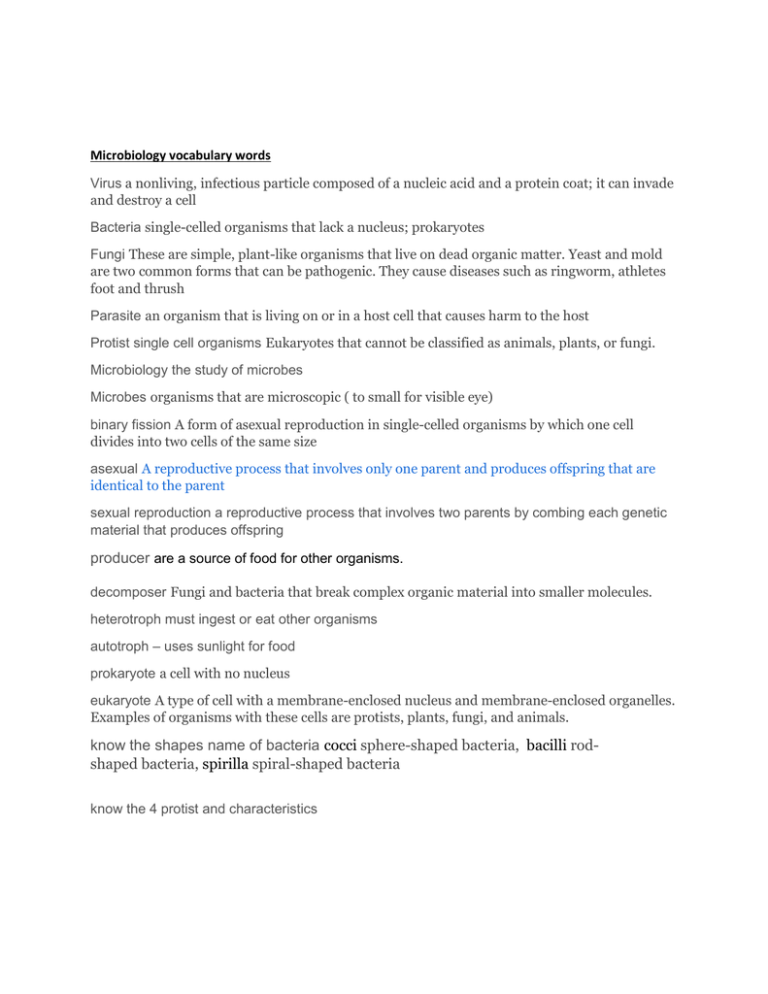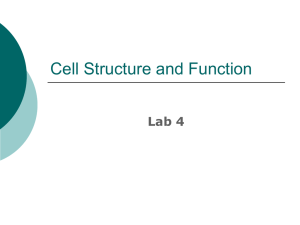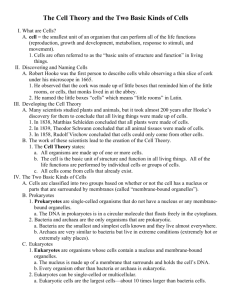Microbiology vocabulary words Virus
advertisement

Microbiology vocabulary words Virus a nonliving, infectious particle composed of a nucleic acid and a protein coat; it can invade and destroy a cell Bacteria single-celled organisms that lack a nucleus; prokaryotes Fungi These are simple, plant-like organisms that live on dead organic matter. Yeast and mold are two common forms that can be pathogenic. They cause diseases such as ringworm, athletes foot and thrush Parasite an organism that is living on or in a host cell that causes harm to the host Protist single cell organisms Eukaryotes that cannot be classified as animals, plants, or fungi. Microbiology the study of microbes Microbes organisms that are microscopic ( to small for visible eye) binary fission A form of asexual reproduction in single-celled organisms by which one cell divides into two cells of the same size asexual A reproductive process that involves only one parent and produces offspring that are identical to the parent sexual reproduction a reproductive process that involves two parents by combing each genetic material that produces offspring producer are a source of food for other organisms. decomposer Fungi and bacteria that break complex organic material into smaller molecules. heterotroph must ingest or eat other organisms autotroph – uses sunlight for food prokaryote a cell with no nucleus eukaryote A type of cell with a membrane-enclosed nucleus and membrane-enclosed organelles. Examples of organisms with these cells are protists, plants, fungi, and animals. know the shapes name of bacteria cocci sphere-shaped bacteria, bacilli rodshaped bacteria, spirilla spiral-shaped bacteria know the 4 protist and characteristics Infectious Diseases Infections illnesses in which live bacterial pathogens are ingested and grow in the body Pathogens Microbes that cause disease immune system a system (including the thymus and bone marrow and lymphoid tissues) that protects the body from foreign substances and pathogenic organisms by producing the immune response white blood cells disease fighting cells in blood antibodies Specialized proteins that aid in destroying infectious agents antiseptics chemical agents that may kill, retard, or prevent the growth of bacteria; antibiotics medicines used to kill or slow growth in bacteria that cause disease antivirals Medicines used to treat a virus once a person is sick but must be given with a few days of exposure. Prevent replication of viruses within host cells vaccination taking a vaccine as a precaution against contracting a disease epidemic a localize outbreak of an infectious disease (ex: Malaria or Rabies) host organism that provides energy (Example: human, dog, tomato) pandemic wide spread (usually worldwide) outbreak of an infectious disease (Ex: Influenza) infectious disease disease caused by the presence of a living thing in the body. Vector an Animal/Insect that carries and transmits a disease Hierarchy of cells Antibiotic Resistance The evolution of populations of bacteria that antibiotics are unable to kill animal cells nucleus,cell membrane, cytoplasm, 1) lacks cell wall 2) lacks chloroplasts 3) lacks large central vacuole plant cells cell wall, vacuole, chloroplasts outbreak the sudden occurrence of a disease, in unexpected numbers in a limited area, w/c then subsides







